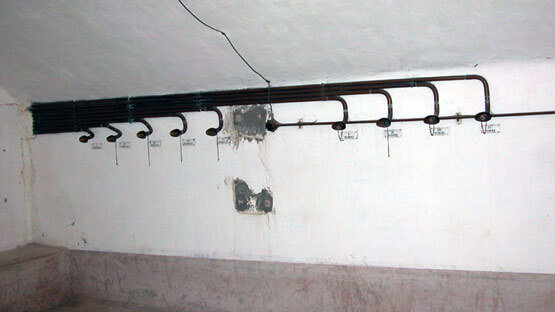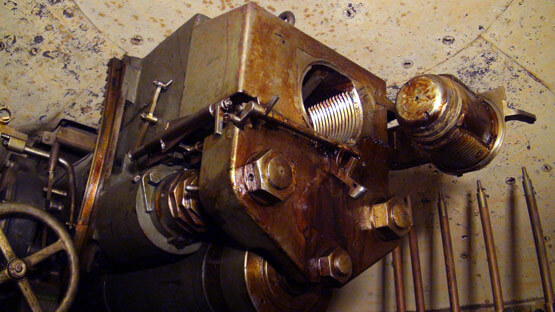The battery corridor: combat command room and guns
In the long corridor that leads to the ammunition dumps and to the towers, the following can be noted: the monkey winches of the lifts and the chain elevators that were needed to bring projectiles and charges from the deposits on the ground floor up to the ammunition dumps on the first floor and, from here, to the gun towers; the ventilation system pumps and conduits; the anchorage points used during heavy maneuvers such as mounting or replacing the gun barrels.
The combat command room
When the battery was in action, it was in this room that all the firing parameters were decided upon: projectile type, propelling charge, rate of fire, elevation, direction, etc.; of note are the observation turret, the telephone panel and the intercom (made up of copper tubes) for communication with the ammunition dump and the gun towers.
The gun towers
The raison d’être of the whole battery is given by the existence of four medium-calibre cannons installed in wells (the towers) dug into a mighty mass of concrete and protected by thick shell-proof steel domes. The systems’ mobility allows a complete 360° of the cannon barrels on the horizontal plane (traverse): the domes move together with the guns so that perfect protection is guaranteed, in every moment, to the arms and to the people operating them. The elevation mechanism allows for a range from -8° to +42° giving a maximum firing range of between 12,100 and 13,600 m.
The armament
The armament of each tower consists of a steel cannon on retractable mount (with two hydraulic brakes and a spring recuperator) 149.1 mm calibre Schneider mk. 1910 (149S), installed in a Schneider naval well, adapted for land use. The 5.4 m (36.24 calibres) long steel barrel is made up of a tube encased by three sleeves, with 48 anti-clockwise grooves with constant pitch cut into the bore. The gun weighs 5,480 kg (3,800 kg of which is the barrel alone), plus 1,428 kg for the mount.
The moving part of the shield (the "dome") consists of two steel half-caps subjected to differential tempering (hardened on the outside) 140-mm thick, internally lined by 12-mm thick sheets of mild steel, arranged in two layers: the total thickness of the dome is 164 mm. The dome is connected elastically, by a shock-absorption device, to the mount which is bolted to the platform: everything revolves on a bearing of 64 conical steel rollers (40 at the base of the dome and 24 under the platform). The non-moving part of the shield (up to 275-mm thick), formed by a convex annulus made of hardened cast iron divided into six sectors, is deeply embedded into the concrete that surrounds the well.
The total weight of the moving parts is 40,840 kg, while the total weight of the installation is 101,298 kg (more than 100 tonnes). Each gun was manned by a team of 6 (one head gunner and 5 gunners). The ammunition was of two types: the 42-kg explosive piercing grenade and the 52-kg shrapnell projectile; the propelling charge (5.7 kg ballistite square tablets, plus additional charges of 0.9 kg each) was contained in gauze bags.



